
Guide
How to improve your living room acoustics
by David Lee

I couldn’t get the acoustics in my living room right, so I’m trying to turn my desk into a short-distance listening paradise. That should be easier, right?
I’m happy to report I’ve made it. I’m sitting at my desk enjoying good sound. All it took was moving the desk towards the middle of the room, rearranging all other furniture, hanging a gigantic, very inappropriate fake fur blanket up behind me to absorb the sound reflections from the wall, layering books under the speakers and adding some notepads at the front to angle them towards my ears. I was just about to take the screen off the desk so it wouldn’t get in the way when reason kicked in. What on earth am I doing? I’ve completely lost sight of my original goal.
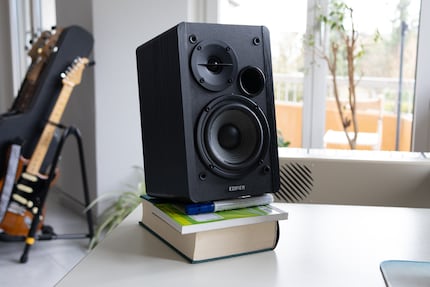
It all started with an idea to solve room acoustics problems with little effort. As I explained in a recent article, you can’t get the acoustics right in every room – especially if you want to keep the room looking good and aren’t prepared to spend a small fortune. The best speakers are useless if the room acoustics are poor.
Headphones are a way of avoiding room acoustics problems. However, the sound from headphones isn’t the same as from loudspeakers. And wearing headphones for a long time can get uncomfortable.
So, might listening to music through speakers that are very close to you be the perfect middle ground between headphones and large hi-fi speakers? After all, this would mean room acoustics play a smaller role, as you can listen at a lower volume and most of the music reaches your ears directly, i.e. without reflecting from walls or other surfaces. Is this how desktop speakers combine the advantages of headphones and loudspeakers?
I’m trying this out with small bookshelf speakers – a pair of Edifier R1280DB. It’s not about these specific speakers, I’m just using them for my proof of concept.
To start off, I place the speakers on my desk. The way it’s positioned, I’m sitting with my back to the wall with about one metre between. That might be unusual, but I want to keep it that way, as I enjoy the view. Being in a corner looking into the room gives me a sense of security.
To the right of the desk, there’s a wall with a window front. This means the right speaker is close to a reflective wall, while the left speaker is free-standing in the room.
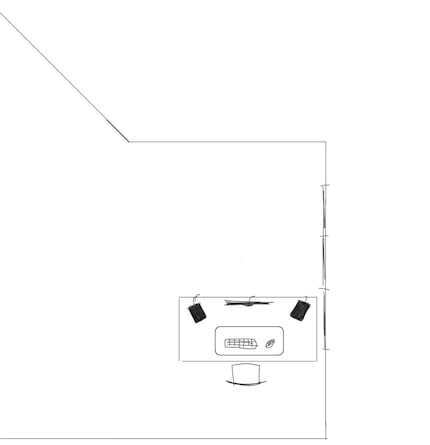
Many desks are positioned with the short side against a wall. Flo and Samuel, who wrote about their desk setup as part of a series, also work at a desk that’s positioned this way.
This setup doesn’t make listening to music fun. Something’s not right. I use a tone generator to check for room modes – bass frequencies that interact with the room in a problematic way. Looks like there really is something going on – at around 50 and 133 Hz, the sound is much louder than in other frequencies. But this isn’t the main problem.
What bothers me most is that the sound’s much louder on the left side than on the right. I’d have expected the speaker at the wall to be louder, but it’s the other way around.
I suspect the sound from the left speaker reflects more on the wall behind me, making it appear louder to me as a result. So, I set up an absorbing element in the corner of the room, remove a possibly reflective Plexiglas holder and place an enormous fake fur blanket on an ironing board to absorb the sound before it hits the wall behind me. Does it sound any better now? Not really. It only gets better when I move the desk away from the window.
When it comes to room acoustics, nothing beats trial and error. After all, the theory’s always based on simplified situations. Everything’s more complicated and difficult to calculate in a real, furnished room.
I set up the speakers on the kitchen table, which is in a corner. This is how many home office desks are positioned – with a wall at two sides.
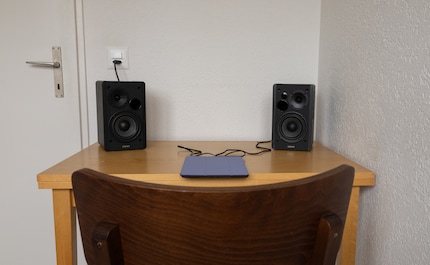
As I expected, the bass is much too loud and boomy in this setup. An equaliser doesn’t solve the problem. Without bass, it just sounds hollow. But the sound’s better balanced than it was at my desk. Interestingly, music from the speaker on the side wall again appears quieter to me.
To get a comparison, I set up the desk so that both speakers are at the same distance from the side wall.
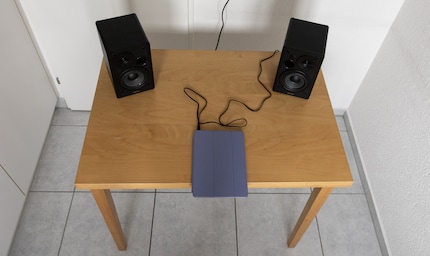
The sound’s much better this way. Although the bass is still quite loud, it doesn’t boom the hell out of me any more. The balance is right. However, reverberation in the room is now all the more noticeable. Mid-range rock songs sound mushy.
So, I drag my improvised monster absorber into the kitchen and position the speakers at a slight angle, hoping the sound will reflect less off the table.
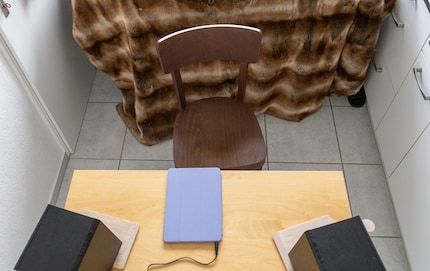
To be sure, I test both measures individually, too, and both work. In combination, the sound in the room is quite okay now. Not as good as in a music studio, but good enough for a home. And when I snap my fingers, there’s no reverberation.
My tests show that even if you’re close to the speakers, room acoustics will still interfere. Speakers on a table that’s positioned with its short side against a wall are a problem. The closest speaker should be at least half a metre away from the wall. Ideally, the table’s in the middle of the room.
Having a wall on the long side of the table is less of a problem – as long as the sides are free. In this case, the wall still amplifies the bass, but at least it does so evenly. If you don’t place the speakers directly against the wall, there shouldn’t be much interference. What’s important, however, is that the opposite wall, i.e. the one behind your back, absorbs sounds to some extent.
If you place bookshelf speakers or studio monitors directly on a table, you have an acoustic problem. Why? The sound reflects off the table surface and the reflection reaches your ear at almost the same time as the direct sound. The problem’s the word «almost». As a result, you’ll hear a mishmash of sound.
PC loudspeakers are better at this. They’re designed to be placed on a table and play sound to someone who’s sitting close, so they direct the sound slightly upwards. Edifier, for instance, also offers angled speakers:
Creating that angle by placing a random item under the speaker works, of course. In my case, it just doesn’t look good. And at high volumes, you might run into a problem with vibrations. There are speaker angling wedges for some speakers, but not for most.
In a music studio, the speakers are usually placed on separate stands behind the console. This way, they’re at ear level. As a result, direct sound reaches the ear first and reflections are less of a problem.
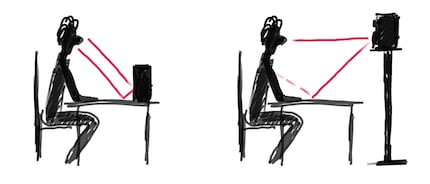
A solution with no table at all is good, too. However, if you want to sit on your sofa and listen to music at a short distance, you’d probably need a wireless system and a stand. Otherwise, there will be too many cables and it won’t look good. If your brain’s going to one of those terrible tiny Bluetooth speakers, stop right there. I doubt that’s what you want if you’re looking for good acoustics.
Turns out being closer to the loudspeakers solves some, but not all room acoustics problems. The room and surrounding you’re in still play a major role and can spoil everything.
After my tests, however, I’d say being close to the speakers makes it easier to isolate and solve specific problems than if the loudspeakers are several metres away. Just watch out for two things: don’t place a speaker right up against a side wall and don’t place a forward-facing speaker directly on a table. Avoid these two scenarios and you’ll be rewarded with decent sound.
My interest in IT and writing landed me in tech journalism early on (2000). I want to know how we can use technology without being used. Outside of the office, I’m a keen musician who makes up for lacking talent with excessive enthusiasm.
Interesting facts about products, behind-the-scenes looks at manufacturers and deep-dives on interesting people.
Show all